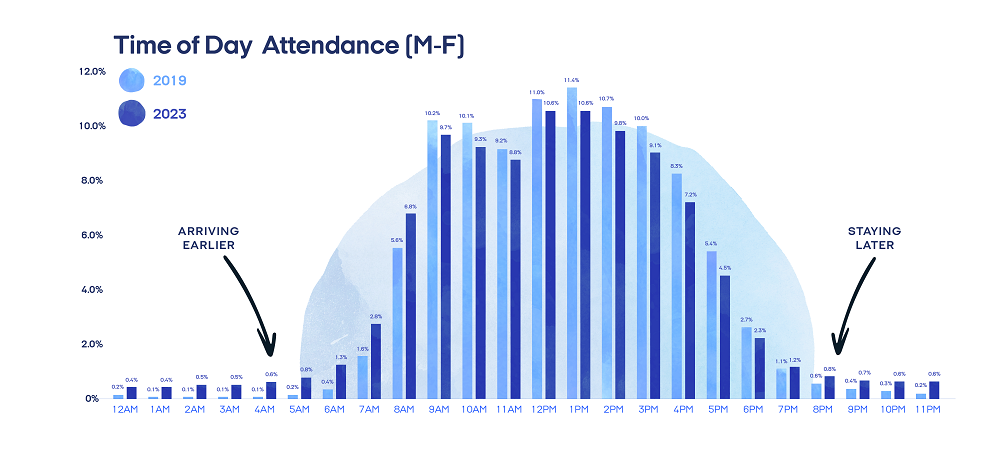Whether we’re thrilled or dragging our feet about returning to the office, there’s a question that lingers: What does our workspace look like now? Post-pandemic, offices have undergone major changes as the real estate industry adapts to hybrid ways of working. Here are three office space trends to watch this year:

1. Offices Are Getting Smaller, but Nicer
Offices are shrinking, continuing a trend from the past decade but accelerating even more now that nearly 74% of companies offer hybrid arrangements. In the next three years, half of the largest international employers are planning to shrink their workspaces. By the middle of 2023, for the first time since 2000, there was less new office space built in the U.S. than torn down or repurposed, breaking ground on 5 million square feet and closing out 14.7 million square feet.
But while offices are getting smaller, they’re also getting mightier. The traditional open concept is giving way to innovative, inviting layouts that enhance collaboration, efficiency, and comfort even with a tighter footprint. This change is not just about optimizing space but also about creating an atmosphere that mirrors the coziness of home. According to architect Brandon Larcom, the workplace “needs to become a destination versus an obligation” in order to get people back at their office desks.
Expect to see more artful, unique, and high-end design trends, from curved hallways and paths that conceal meeting rooms in plain sight to modular furniture that makes it easy to flip a space from heads-down individual work to full-on collaboration. Office furniture will continue trending away from rows of desks to a more welcoming layout with couches, armchairs, stools, and bistro tables—even fireplaces. Whatever helps make the employees comfortable, creative, and sparking off new ideas.
2. Flexibility Isn’t Just about Working from Home
Heading back to the office doesn’t mean saying goodbye to the flexibility employees got used to during the pandemic. In fact, businesses must adapt their spaces more than ever to accommodate diverse working preferences and remote habits. Failing to do so may stop employees from making the effort to come in—especially when their home setup perfectly suits their needs.
The office of tomorrow will have more open environments that accommodate varied working preferences, according to real estate firm Cushman & Wakefield. For example, while some employees can work in loud, noisy environments, others require complete silence to stay focused on tasks. This means bringing in more quiet spaces such as private phone booths and pods, while continuing to maintain the lively common areas and open-plan kitchens. Since office space is getting smaller, striking this balance between so many different preferences is tricky.
Whether working at a desk or by the fireplace, the main focus should be productivity, not just feng shui. Instead of splurging on game rooms or beer fridges, companies are emphasizing practical features such as mental wellness rooms, outdoor workspaces, and lactation rooms. Catering to employee preferences doesn’t mean unnecessary luxuries, but a focus on building the most conducive environment for getting work done. Comfort in the name of progress.
3. Days in the Office Are Fewer, but Longer
There’s a new pattern of foot traffic to expect from employees.
While there have been headlines suggesting Wednesday is the busiest day of the week for office attendance, Bevi has analyzed dispense data from our Smart Water Coolers—which are found in thousands of offices across all 50 states—and seen that Tuesday and Wednesday actually have similar attendance rates.
Whereas office attendance was more evenly dispersed across the five-day work week before the pandemic, the time employees are spending in office has condensed around the middle of the week. When employees have the autonomy to choose when they come in, they primarily choose Tuesday to Thursday, with fewer trips in on Monday and Friday.

While people are in the office fewer days per week, their days seem to be getting longer. A greater portion of in-office hours now take place before 9 a.m. and after 5 p.m. than before the pandemic. This could be a strategy to avoid the commute, and it’s possible people are falling into two camps: starting earlier in order to leave earlier, or coming in later and leaving later. One thing is clear: fewer people are working the traditional eight hours.

What’s Next?
Since the sharp decline at the start of 2020, national workplace attendance has been steadily increasing and is projected to keep rising in 2024. Companies will continue to offer flexible working arrangements, but they will also promote return-to-office more to ensure that people in different departments stay connected to each other and that new people are learning. And recent college grads will primarily seek “office first” jobs in an effort to absorb more knowledge and jump-start their careers.
Looking ahead, employees facing the potential threat of displacement from lower-cost alternatives, including workers in countries with lower GDP and AI bots interfacing with ChatGPT, will increasingly value personal relationships as a crucial factor in effective work. This will likely drive even greater in-person attendance.
When it comes down to figuring out the future office plan, think of these employees and their changing work environment, split between the office and home, informed by advanced new tools. Their health, wellness, productivity, and business continuity should take the utmost importance in how the post-pandemic office space functions, according to Joseph Allen, director of Harvard’s Healthy Buildings Program and associate professor at the Harvard T.H. Chan School of Public Health.
“Major organizations are rethinking their approach to commercial real estate …because the C-suite has started to really pay attention to the key role that buildings play in the health of their people and their company,” he said.
To learn more about post-pandemic office trends, make sure to download the FREE whitepaper “Workplace Amenities that Actually Matter.”
Sean Grundy is co-founder and CEO of Bevi, a brand of smart water coolers developed to make the beverage industry more sustainable. Prior to founding Bevi in 2013, he worked in water conservation at an environmental nonprofit organization in the U.S. and China. He has an MBA from MIT and a BA in Philosophy from Princeton University.
